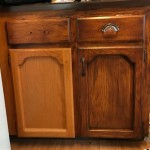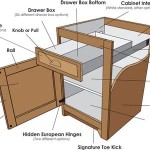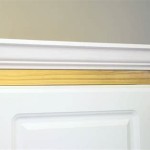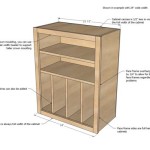Corner Kitchen Cupboard Organization: Maximizing Space and Efficiency
Corner kitchen cupboards, often lauded for their ability to maximize space utilization in a compact kitchen layout, frequently present unique organizational challenges. The inherent depth and awkward angles of these cupboards can transform them into frustrating voids where items become lost or inaccessible. Effective organization is paramount to unlocking the true potential of a corner cupboard, transforming it from a chaotic storage space into a functional and efficient element of the kitchen.
The key to successful corner cupboard organization lies in understanding the specific limitations and opportunities presented by its design. Blind corner cupboards, for instance, extend deep into the corner of the kitchen, making access to items stored at the back particularly difficult. Lazy Susans, pull-out shelves, and other specialized hardware solutions can mitigate these challenges, bringing items within easy reach. Conversely, corner cupboards with angled fronts may offer more accessible storage space but require careful planning to avoid wasted areas and optimize the placement of items.
This article will explore various strategies and techniques for organizing corner kitchen cupboards, aiming to provide a comprehensive guide to maximizing space, improving accessibility, and maintaining an organized kitchen environment. The focus will be on practical solutions that can be implemented in a variety of kitchen layouts and with different types of corner cupboards.
Evaluating Existing Space and Identifying Organizational Needs
The first step in organizing any kitchen cupboard, including corner units, involves a thorough evaluation of the existing space and a clear identification of organizational needs. This process will inform decisions regarding storage solutions, item placement, and overall cupboard layout.
Begin by completely emptying the corner cupboard. This allows for a clear assessment of the available space and provides an opportunity to clean the interior. Use a vacuum cleaner to remove dust and debris from the shelves and corners. Wipe down the interior surfaces with a damp cloth and mild detergent to remove any spills or stains. Once the cupboard is clean and dry, proceed to the next step.
Next, analyze the items that were previously stored in the corner cupboard. Categorize these items based on their type (e.g., cookware, small appliances, dry goods), frequency of use, and size. Discard any items that are no longer needed, expired, or damaged. This decluttering process is essential for maximizing space and ensuring that only useful items are stored in the cupboard.
Consider the specific challenges presented by the corner cupboard's design. Are items difficult to reach at the back? Is there a significant amount of wasted space due to the shape of the cupboard? Identify these challenges and prioritize solutions that address them. For example, if items are difficult to reach, a lazy Susan or pull-out shelves may be necessary. If there is wasted space, consider using shelf organizers or storage containers to maximize the available area.
Finally, determine the organizational needs based on the categories of items to be stored. Frequently used items should be placed in easily accessible locations, while less frequently used items can be stored further back. Consider the size and shape of each item when determining its placement, ensuring that larger items do not obstruct access to smaller items.
Implementing Effective Storage Solutions
Once the existing space has been evaluated and organizational needs have been identified, the next step is to implement effective storage solutions. This involves selecting and installing appropriate hardware, organizers, and containers to maximize space utilization and improve accessibility.
Lazy Susans are a popular solution for corner cupboards, particularly those with deep recesses. These rotating shelves allow for easy access to items stored at the back of the cupboard. They are available in various sizes and materials, including plastic, wood, and metal. When selecting a lazy Susan, consider the size of the cupboard, the weight of the items to be stored, and the desired aesthetic.
Pull-out shelves are another excellent option for improving accessibility. These shelves slide out from the cupboard, bringing items within easy reach. They are particularly useful for storing heavy or bulky items, such as pots and pans. Pull-out shelves can be custom-made to fit the specific dimensions of the corner cupboard or purchased in standard sizes. Ensure that the shelves are sturdy enough to support the weight of the items to be stored and that they slide smoothly and easily.
Shelf organizers, such as tiered shelves and risers, can help to maximize vertical space within the corner cupboard. Tiered shelves allow for the storage of multiple items on a single shelf, while risers create additional storage space above items such as plates or bowls. These organizers are particularly useful for storing small items, such as spices or canned goods.
Storage containers, such as bins, baskets, and boxes, can be used to corral loose items and prevent them from getting lost in the corner cupboard. Clear containers are particularly useful, as they allow for easy identification of the contents. Labeling the containers can further enhance organization and make it easier to find specific items. Choose containers that are appropriately sized for the items to be stored and that fit comfortably within the cupboard.
For items that are used infrequently, consider storing them in the back of the corner cupboard or in a less accessible location. This frees up prime storage space for items that are used more frequently. Label these items clearly to ensure that they can be easily located when needed.
Maintaining Organization and Preventing Clutter
Implementing effective storage solutions is only half the battle. Maintaining organization and preventing clutter are essential for ensuring that the corner kitchen cupboard remains functional and efficient over time. This requires establishing regular maintenance routines and adopting organizational habits.
Establish a regular cleaning schedule for the corner cupboard. Aim to clean the cupboard at least once a month, or more frequently if necessary. This involves removing any accumulated dust or debris, wiping down the shelves, and checking for expired or damaged items. A clean cupboard is easier to organize and maintain.
Implement a "one in, one out" rule for new items. This means that for every new item that is added to the corner cupboard, an existing item must be removed. This prevents the cupboard from becoming overcrowded and ensures that only necessary items are stored there. If an item is no longer needed, donate it, sell it, or discard it.
Regularly declutter the corner cupboard. At least once a year, completely empty the cupboard and evaluate the items that are stored there. Discard any items that are no longer needed, expired, or damaged. Reorganize the remaining items based on their frequency of use and size. This process helps to maintain organization and prevent the accumulation of clutter.
Designate specific locations for different types of items within the corner cupboard. This makes it easier to find specific items when needed and prevents items from being misplaced. Use labels to clearly identify the contents of each location. For example, one section of the cupboard could be designated for cookware, another for small appliances, and another for dry goods.
Encourage all members of the household to participate in maintaining the organization of the corner cupboard. Emphasize the importance of putting items back in their designated locations after use and of decluttering regularly. This helps to ensure that the cupboard remains organized and functional for everyone.
Consider using a kitchen inventory system to track the items stored in the corner cupboard. This can be as simple as a written list or a more sophisticated spreadsheet. The inventory system can help to prevent over-purchasing and ensure that items are used before they expire. It can also be used to track the location of specific items within the cupboard.
By implementing these strategies and techniques, it is possible to transform a corner kitchen cupboard from a chaotic storage space into a functional and efficient element of the kitchen. With careful planning, effective storage solutions, and consistent maintenance, the corner cupboard can become a valuable asset in any kitchen.
Ultimately, the key to successful corner kitchen cupboard organization lies in adapting these principles to the specific needs and limitations of the individual kitchen layout and storage requirements. Regular evaluation and adjustment of organizational strategies will ensure that the corner cupboard remains a functional and efficient part of the kitchen for years to come.

Iheart Organizing Organized Kitchen Corner Cabinet With A Diy Lazy Susan

Corner Cabinet Organizers Kitchen Storage Ideas

Iheart Organizing Organized Kitchen Corner Cabinet With A Diy Lazy Susan

Corner Cabinet Organizers Kitchen Storage Ideas

Kitchen Organization Ideas Corner Cabinet

Corner Cabinet Organizers Kitchen Storage Ideas

Iheart Organizing Organized Kitchen Corner Cabinet With A Diy Lazy Susan

Organizing Pots And Pans In A Corner Cabinet Smallish Home

Upper Corner Kitchen Cabinet Solutions Live Simply By Annie

How To Deal With The Blind Corner Kitchen Cabinet Live Simply By Annie








